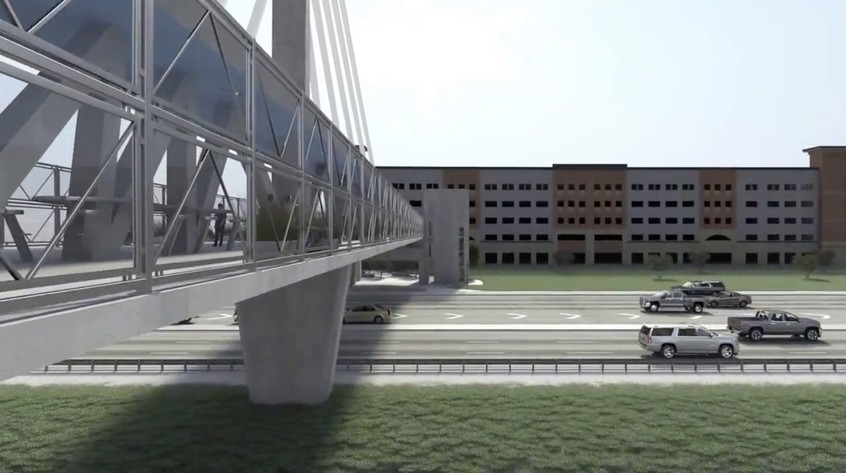Six people are confirmed dead after a pedestrian bridge installed only five days earlier collapsed onto cars at Florida International University (FIU) in Miami yesterday.
Hailed as a triumph of modern methods of construction, the 174-foot, 950-ton section of the bridge was built on the roadside to minimise traffic disruption before being lifted and rotated into position over an eight-lane street during the night of Saturday, 10 March.
The method, called Accelerated Bridge Construction, is being advanced by a specialist unit of the university’s own civil engineering department.
We will get to the truth for the sake of the family– Juan Perez, Miami-Dade Police
But yesterday afternoon the bridge collapsed without warning, crushing at least eight vehicles stopped at traffic lights below on the busy Southwest Eighth Street in the Sweetwater area of the city. Nine people were injured, Miami-Dade Police said.
Police announced the fatalities this morning after rescuers with sniffer dogs spent the night searching for victims trapped by the structure.
The operation was now moving from rescue to recovery, and investigation into the causes of the collapse, police said.
“We will get to the truth for the sake of the family,” tweeted Juan Perez, director of the Miami-Dade Police Department.
Costing $14.2m, and financed by the US Department of Transportation, the FIU-Sweetwater UniversityCity Bridge was intended to provide a long-requested safe link for students from the university to a student housing area over the busy thoroughfare.
In August 2017, a student was hit and killed by cars while crossing the busy road, according to reports.
It was also meant to be an example of the safe and efficient bridge construction method being researched and promoted by FIU’s Accelerated Bridge Construction (ABC) University Transportation Center.

Render of the completed FIU-Sweetwater UniversityCity Bridge. It was to provide study and gathering spaces, as well as a safe link to a student housing area (FIU/FIGG)
“FIU is about building bridges and student safety. This project accomplishes our mission beautifully,” said FIU President Mark B. Rosenberg after the bridge was lifted into place on Saturday.
“We are filled with pride and satisfaction at seeing this engineering feat come to life and connect our campus to the surrounding community where thousands of our students live.”
The chair of FIU’s Civil & Environmental Engineering Department, and director of its ABC center, Atorod Azizinamini, called it “an outstanding example of the ABC method”.
In May 2016 two firms were selected to design and build the bridge: award-winning Tallahassee-based FIGG Bridge Engineers for the design, and Miami family firm, Munilla Construction Management (MCM) for construction.
According to FIU, roadside construction of the bridge deck started in the spring of last year, and the bridge in its entirety was expected to be completed in early 2019.
The university and its builders took pride in two other aspects of the bridge and its erection Saturday.
The university said it was the “largest pedestrian bridge moved via self-propelled modular transportation in US history”.
It was also the first in the world to be constructed entirely of self-cleaning concrete, the university said. When exposed to sunlight, the titanium dioxide in the concrete captures pollutants and turns it bright white, reducing maintenance costs.
The 32-foot-wide covered bridge was also to serve as study and gathering space.
The collapse has left many in the university and city shocked and devastated.
“Today is a dark day in our history,” FIU’s president Mark B. Rosenberg said in a statement on the university’s website last night.
“Just five days ago, we stood on SW 8th Street, united in celebration. Tonight we grieve for all the victims of the bridge collapse.
“The bridge that was being built was about collaboration, hope, opportunity, and determination.
“About strength and unity. About being good neighbours. About goodness. Not sadness.
“Now we are feeling immense sadness.”
Top image: Aerial view of the accident site soon after the bridge collapsed (Miami-Dade Police aviation unit via Twitter)
Comments
Comments are closed.











I understand that the bridge was being tested when it collapsed, if so why was the road underneath open to traffic?
Such a shame, and a sad loss of life!!
Great sorrow for the loss of life and the injured.
Apart from potential engineering or construction error one must review what impact that any accelerated speed that was attached to all the process from inception to delivery may have had on this horrific accident.
I do hope the investigation team take this as a potential impact during their study into the collapse for speed carries risks in addition to all the other potential errors.